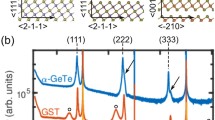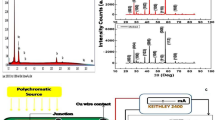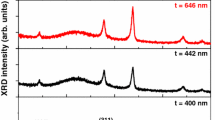Abstract
The growth of Sb2S3−xSex (x = 0, 0.1, 0.2, 0.3) crystals is carried out by the Bridgman technique with the help of a joule heating vertical zone furnace. This paper mainly addresses the thermoelectric properties and photoresponse of grown crystals. The crystals are found to be pure and stoichiometric, as observed from the EDAX spectra. The X-ray diffractogram confirmed orthorhombic structure with space group Pnma and the ‘2θ’ shift in XRD peaks confirmed the substitution of S by Se atoms. Low-temperature Raman spectroscopy from 80 to 300 K shows a shift in the Raman peak and the value of the isobaric Gruneisen parameter γiP is found to be nearly 3.88 for all samples. Raman mapping spectroscopy confirmed the homogeneity of the crystals by depth profiling up to 10 microns. All the samples show a negative temperature coefficient of resistance confirming the semiconducting nature of the grown crystals. A slight increase in thermal conductivity is observed due to increased carrier concentration by Se atoms. The temperature dependence of thermoelectric parameters is measured from ambient to 600 K. The positive value of Seebeck coefficient S confirmed the p-type conductivity for all the crystals and the thermoelectric figure of merit ZT is increased for Sb2S2.7Se0.3 crystal compared to pure Sb2S3. The I–V characteristic and photoresponse of the grown crystals are investigated and the responsivity and detectivity are both found to increase with Se incorporation. As per our knowledge ZT for this series of crystals is not reported anywhere in the literature.













Similar content being viewed by others
Data availability
Data will be made available on request.
References
T. Ben Nasr, H. Maghraoui-Meherzi, H. Ben Abdallah, R. Bennaceur, Electronic structure and optical properties of Sb2S3 crystal. Phys. B Condens. Matter 406(2), 287–292 (2011). https://doi.org/10.1016/j.physb.2010.10.070
R. Kondrotas, C. Chen, J. Tang, Sb2S3 solar cells. Joule. 2(5), 857–878 (2018). https://doi.org/10.1016/j.joule.2018.04.003
A. Radzwan, A. Lawal, A. Shaari, I.M. Chiromawa, S.T. Ahams, R. Ahmed, First-principles calculations of structural, electronic, and optical properties for Ni-doped Sb2S3. Comput. Condens. Matter (2020). https://doi.org/10.1016/j.cocom.2020.e00477
B. Vengatesan, N. Kanniah, P. Ramasamy, Growth of Sb2S3 single crystals by chemical vapour transport. Mater. Chem. Phys. 17(3), 311–316 (1987). https://doi.org/10.1016/0254-0584(87)90153-2
V. Patil, A. Patil, J.W. Choi, Y.S. Jin, Thickness dependent properties of nanocryastalline Sb2S3 electrode. IEEE Nanotechnol. Mater. Devices Conf. NMDC 1, 172–173 (2006). https://doi.org/10.1109/NMDC.2006.4388732
R.G. Sotelo Marquina, T.G. Sanchez, N.R. Mathews, X. Mathew, Vacuum coated Sb2S3 thin films: thermal treatment and the evolution of its physical properties. Mater. Res. Bull. 90, 285–294 (2017). https://doi.org/10.1016/j.materresbull.2017.03.013
P.K. Nair et al., Antimony sulfide-selenide thin film solar cells produced from stibnite mineral. Thin Solid Films. 645, 305–311 (2018). https://doi.org/10.1016/j.tsf.2017.11.004
M. Courel, T. Jiménez, A. Arce-Plaza, D. Seuret-Jiménez, J.P. Morán-Lázaro, F.J. Sánchez-Rodríguez, A theoretical study on Sb2S3 solar cells: the path to overcome the efficiency barrier of 8%. Sol. Energy Mater. Sol. Cells. 201, 110123 (2019). https://doi.org/10.1016/j.solmat.2019.110123
U.A. Shah, S. Chen, G.M.G. Khalaf, Z. Jin, H. Song, Wide bandgap Sb2S3 solar cells. Adv. Funct. Mater. 31(27), 1–28 (2021). https://doi.org/10.1002/adfm.202100265
H. Lei et al., Copper doping of Sb2S3: fabrication, properties, and photovoltaic application. J. Mater. Sci. Mater. Electron. 30, 21106–21116 (2019). https://doi.org/10.1007/s10854-019-02481-9
A.A. Ebnalwaled, Evolution of growth and enhancement in power factor of InSb bulk crystal. J. Cryst. Growth. 311, 4385–4390 (2009). https://doi.org/10.1016/j.jcrysgro.2009.07.040
T. Ben Nasr, H. Maghraoui-Meherzi, N. Kamoun-Turki, First-principles study of electronic, thermoelectric and thermal properties of Sb2S3. J. Alloys Compd. 663, 123–127 (2016). https://doi.org/10.1016/j.jallcom.2015.12.093
D. Zhao, G. Tan, A review of thermoelectric cooling: materials, modeling and applications. Appl. Therm. Eng. 66, 1–2 (2014). https://doi.org/10.1016/j.applthermaleng.2014.01.074
L. Grad, F.O. Von Rohr, M. Hengsberger, J. Osterwalder, Charge carrier dynamics and self-trapping on Sb2S3(100). Phys. Rev. Mater. 5(7), 1–8 (2021). https://doi.org/10.1103/PhysRevMaterials.5.075401
R. Chetty, A. Bali, R.C. Mallik, Thermoelectric properties of indium doped Cu2CdSnSe4. Intermetallics 72, 17–24 (2016). https://doi.org/10.1016/j.intermet.2016.01.004
C. Fu et al., Realizing high figure of merit in heavy-band p-type half-heusler thermoelectric materials. Nat. Commun. 6, 4–10 (2015). https://doi.org/10.1038/ncomms9144
Y. Li, G. Wang, M. Akbari-Saatlu, M. Procek, H.H. Radamson, “Si and SiGe nanowire for micro-thermoelectric generator: a review of the current state of the art.” Front. Mater. 8, 1–24 (2021)
M. Noroozi et al., Unprecedented thermoelectric power factor in SiGe nanowires field-effect transistors. ECS J. Solid State Sci. Technol. 6(9), Q114–Q119 (2017). https://doi.org/10.1149/2.0021710jss
O. Flores-Ventura, M. Courel, T.G. Sanchez, N.R. Mathews, X. Mathew, “Obtaining the solid solution Sb2S3–xSex by selenization of Sb2S3 film and identifying the thermal processing parameters to achieve recrystallization while maintaining phase-purity,.” Mater. Sci. Semicond. Process. 135, 106081 (2021). https://doi.org/10.1016/j.mssp.2021.106081
D.Y.W. Yu, H.E. Hoster, S.K. Batabyal, Bulk antimony sulfide with excellent cycle stability as next-generation anode for lithium-ion batteries. Sci. Rep. 4, 1–6 (2014). https://doi.org/10.1038/srep04562
S.I. Beril, I.G. Stamov, A.V. Tiron, V.V. Zalamai, N.N. Syrbu, Frenkel excitons and band structure in Sb2S3 single crystals. Opt. Mater. (Amst). 101, 109737 (2020). https://doi.org/10.1016/j.optmat.2020.109737
C. Wu et al., Direct solution deposition of device quality Sb2S3–xSex films for high efficiency solar cells. Sol. Energy Mater. Sol. Cells 183, 52–58 (2018). https://doi.org/10.1016/j.solmat.2018.04.009
P.A. Chate, S.D. Lakde, Characteristics of Sb2S3 thin films deposited by a chemical method. Int. J. Thin Film Sci. Technol. 4(3), 237–242 (2015)
A. Kyono, A. Hayakawa, M. Horiki, Selenium substitution effect on crystal structure of stibnite (Sb2S3). Phys. Chem. Miner. 42(6), 475–490 (2015). https://doi.org/10.1007/s00269-015-0737-x
A. Shongalova, M.R. Correia, B. Vermang, J.M.V. Cunha, P.M.P. Salomé, P.A. Fernandes, On the identification of Sb2Se3 using Raman scattering. MRS Commun. 8(3), 865–870 (2018). https://doi.org/10.1557/mrc.2018.94
F. Perales, G. Lifante, F. Agulló-Rueda, C. De Las Heras, Optical and structural properties in the amorphous to polycrystalline transition in Sb2S3 thin films. J. Phys. D Appl. Phys. 40(8), 2440–2444 (2007). https://doi.org/10.1088/0022-3727/40/8/005
S.V. Bhatt, M.P. Deshpande, V. Sathe, S.H. Chaki, Effect of pressure and temperature on Raman scattering and an anharmonicity study of tin dichalcogenide single crystals. Solid State Commun. 201, 54–58 (2015). https://doi.org/10.1016/j.ssc.2014.10.009
H.R. Bhoi et al., Effects of different Bismuth concentrations of InSbBi crystals grown by Bridgman technique. J. Cryst. Growth. 599, 126904 (2022). https://doi.org/10.1016/j.jcrysgro.2022.126904
C.K. Gan, J.R. Soh, Y. Liu, Large anharmonic effect and thermal expansion anisotropy of metal chalcogenides: the case of antimony sulfide. Phys. Rev. B Condens. Matter Mater. Phys. 92(23), 23–26 (2015). https://doi.org/10.1103/PhysRevB.92.235202
K. Chauhan, M.P. Deshpande, K.N. Patel, S.H. Chaki, S. Pandya, Structural, morphological and vibrational properties of Bi substituted Sb2S3 nanoparticles. Mater. Res. Express. 5(10), 105005 (2018). https://doi.org/10.1088/2053-1591/aadab2
J. Wang, D. Chen, Y. Xu, Q. Liu, L. Zhang, Influence of the crystal texture on Raman spectroscopy of the AlN films prepared by pulse laser deposition. J. Spectrosc. (2013). https://doi.org/10.1155/2013/103602
T. Tsukamoto, N. Hirose, A. Kasamatsu, T. Matsui, Y. Suda, Evaluation of crystallinity of lattice-matched Ge/GeSiSn heterostructure by Raman spectroscopy. Thin Solid Films. 726, 138646 (2021). https://doi.org/10.1016/j.tsf.2021.138646
B. Roy, B.R. Chakraborty, R. Bhattacharya, A.K. Dutta, Electrical and magnetic properties of antimony sulphide (Sb2S3) crystals and the mechanism of carrier transport in it. Solid State Commun. 25(11), 937–940 (1978). https://doi.org/10.1016/0038-1098(78)90306-X
B.B. Nayak, H.N. Acharya, Electrical and thermoelectric properties of Sb2S3 thin films prepared by the dip-dry method. Thin Solid Films. 122(2), 93–103 (1984). https://doi.org/10.1016/0040-6090(84)90001-4
Z.M. Gibbs, H.S. Kim, H. Wang, G.J. Snyder, Band gap estimation from temperature dependent Seebeck measurement–deviations from the 2e|S|maxTmax relation. Appl. Phys. Lett. 106(2), 0–5 (2015). https://doi.org/10.1063/1.4905922
B.R. Chakraborty, B. Ray, R. Bhattacharya, A.K. Dutta, Magnetic and electric properties of antimony selenide (Sb2Se3) crystals. J. Phys. Chem. Solids. 41(8), 913–917 (1980). https://doi.org/10.1016/0022-3697(80)90037-2
X. Zhang et al., Band convergence and thermoelectric performance enhancement of InSb via Bi doping. Intermetallics. 139, 107347 (2021). https://doi.org/10.1016/j.intermet.2021.107347. September
S. Patel, S.H. Chaki, P.C. Vinodkumar, Effect of indium and antimony doping on the transport properties of direct vapour transport (DVT) grown SnSe single crystals. J. Appl. Phys. (2018). https://doi.org/10.1063/1.5048832
A.A. Abd El-Rahman, K.K. Tahoon, M.A. Abd El-Salam, A.E.S. Abd Elwahab, Temperature dependence of the thermophysical properties of polycrystalline chalcogenide glasses: mercury and antimony sulphides. J. Therm. Anal. 47(6), 1719–1728 (1996). https://doi.org/10.1007/bf01980917
L.V. Prokofieva, D.A. Pshenay-Severin, P.P. Konstantinov, A.A. Shabaldin, Optimum composition of a Bi2Te3–xSex alloy for the n-type leg of a thermoelectric generator. Semiconductors 43(8), 973–976 (2009). https://doi.org/10.1134/S1063782609080016
Z. Chen et al., Thermoelectric properties and thermal stability of bi-doped PbTe single crystal. Phys. B Condens. Matter. 538, 154–159 (2018). https://doi.org/10.1016/j.physb.2018.03.033
R. Basu et al., Improved thermoelectric performance of hot pressed nanostructured n-type SiGe bulk alloys. J. Mater. Chem. A 2, 6922–6930 (2014). https://doi.org/10.1039/c3ta14259k
C.H. Su, Thermal stability of melt grown Tl-doped PbTeSe material for thermoelectric applications. Mater. Sci. Semicond. Process. 56, 94–99 (2016). https://doi.org/10.1016/j.mssp.2016.07.024
R.H. Bube, Photoelectronic analysis of high resistivity crystals: (A) GaAs, (b) Sb2S3. J. Appl. Phys. 31(2), 315–322 (1960). https://doi.org/10.1063/1.1735564
B.G. Valmik et al., Investigation and fabrication of cadmium telluride (CdTe) single crystal as a photodetector. Phys. B Condens. Matter 614, 413027 (2021). https://doi.org/10.1016/j.physb.2021.413027
Acknowledgements
The authors would like to express their gratitude to the Sophisticated Instrumentation Centre for Applied Research and Technology, (SICART), V. V. Nagar, Gujarat, India, for the characterization of samples by EDAX and XRD. The authors are thankful to the University Science and Instrumentation Centre (USIC), Sardar Patel University, V. V. Nagar, Gujarat, India, for the preparation and vacuum sealing of the quartz ampoule.
Funding
The authors have no relevant funding to disclose.
Author information
Authors and Affiliations
Contributions
Writing original draft, Data curation, Formal analysis and Methodology: HRB, Supervision, Visualization and Writing review & editing: MPD, Conceptualization, Formal analysis and Methodology: SVB, Formal analysis and Resources: PR, Software and Investigation: SP, Formal analysis and Data curation: YVJ, Formal analysis and Data curation: ZRP, Formal analysis and Visualization: NMS, Data curation and Validation: V.GS, Formal analysis and Resources: SHC.
Corresponding author
Ethics declarations
competing interest
The authors declare that they have no known competing financial interests or personal relationships that could have appeared to influence the work reported in this paper.
Additional information
Publisher’s Note
Springer Nature remains neutral with regard to jurisdictional claims in published maps and institutional affiliations.
Rights and permissions
Springer Nature or its licensor (e.g. a society or other partner) holds exclusive rights to this article under a publishing agreement with the author(s) or other rightsholder(s); author self-archiving of the accepted manuscript version of this article is solely governed by the terms of such publishing agreement and applicable law.
About this article
Cite this article
Bhoi, H.R., Deshpande, M.P., Bhatt, S.V. et al. Investigation of thermoelectric properties and photoresponse of Sb2S3−xSex crystals grown by Bridgman technique. J Mater Sci: Mater Electron 34, 1217 (2023). https://doi.org/10.1007/s10854-023-10631-3
Received:
Accepted:
Published:
DOI: https://doi.org/10.1007/s10854-023-10631-3




